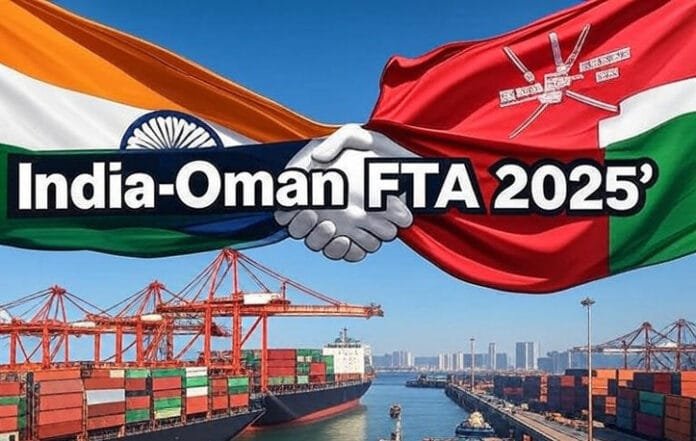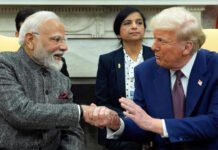The long-anticipated Free Trade Agreement (FTA) between India and Oman is on the verge of finalization, with both nations preparing for a formal announcement within the next two to three months. This landmark accord, officially termed the Comprehensive Economic Partnership Agreement (CEPA), is expected to redefine the economic relationship between the two countries, boosting bilateral trade, investment flows, and strategic cooperation across multiple sectors.
Final Stages Before Official Announcement
According to senior officials, the FTA draft is undergoing translation into Arabic in Oman, a procedural step before it is presented for cabinet approval in both nations. Once ratified, the agreement will be signed and announced jointly. This timeline suggests that by late 2025, the CEPA will be a fully operational framework guiding India-Oman trade relations.
The decision to expedite the process underscores the mutual strategic interest shared by New Delhi and Muscat, aiming to fortify economic and geopolitical ties in a region of immense significance to India’s energy security and trade networks.
Background and Negotiation Timeline
Formal negotiations for the India-Oman CEPA commenced in November 2023, following high-level diplomatic engagements and trade dialogues. Over the course of several negotiation rounds, both sides reached consensus on reducing or eliminating customs duties on a substantial percentage of traded goods, liberalizing service trade policies, and facilitating cross-border investments.
The agreement builds on India’s successful UAE CEPA model, which came into force in May 2022, resulting in notable trade expansion within the Gulf Cooperation Council (GCC) region. Oman, as a key GCC member, represents the third-largest export destination for India among GCC states, after the UAE and Saudi Arabia.
Key Provisions of the India-Oman CEPA
Under the upcoming CEPA, both nations will commit to a wide range of trade-enhancing measures, including:
Tariff Elimination: Gradual removal or substantial reduction of customs duties on key export and import commodities.
Services Liberalization: Easing of restrictions in sectors such as IT, financial services, shipping, healthcare, and education.
Investment Protection: Clearer regulations and safeguards to encourage long-term foreign direct investment (FDI).
Trade Facilitation Measures: Streamlined customs procedures, digital trade documentation, and reduced bureaucratic hurdles.
Sectoral Cooperation: Joint initiatives in energy, infrastructure, manufacturing, and technology transfer.
Strategic Importance of Oman in India’s Trade Network
Oman’s geo-strategic location at the mouth of the Arabian Sea and proximity to major shipping lanes connecting the Gulf, Africa, and Asia makes it a vital partner for India’s maritime trade ambitions. The Port of Duqm, where India has secured strategic access, offers a crucial logistics hub for energy shipments and naval operations.
With strong historical and cultural links, Oman has long been a gateway for India’s exports to the Middle East and Africa. The CEPA will now institutionalize these trade flows, offering predictability and stability to business operations.
India-Oman Bilateral Trade Performance
In the 2024–25 fiscal year, bilateral trade between the two nations exceeded US$10 billion, reflecting the depth of economic engagement:
Exports from India to Oman: US$4.06 billion
Imports from Oman to India: US$6.55 billion
This trade pattern reflects Oman’s position as a key energy supplier to India, alongside growing opportunities for Indian manufacturing exports, engineering goods, and services in the Omani market.
Major Imports from Oman to India
Oman’s exports to India are heavily concentrated in energy and industrial raw materials. The top imports include:
Petroleum Products – A critical input for India’s refining and energy sectors.
Urea – A vital fertilizer for India’s agricultural productivity.
Polymers of Propylene and Ethylene – Essential for the plastics and packaging industry.
Pet Coke – Widely used in cement manufacturing.
Gypsum – Important in construction and cement industries.
Industrial Chemicals – Used across multiple manufacturing processes.
Iron and Steel Products – Raw materials for infrastructure and heavy industries.
Combined, petroleum products and urea account for over 70% of India’s total imports from Oman.
India’s Export Potential to Oman
India’s exports to Oman span a broad range of sectors, with the potential for further growth under the CEPA:
Engineering Goods – Machinery, electrical equipment, and transport vehicles.
Pharmaceuticals – Affordable generics and specialty medicines.
Food and Agro Products – Rice, spices, marine products, and processed foods.
Textiles and Apparel – Cotton fabrics, readymade garments, and home textiles.
Gems and Jewelry – Gold, diamonds, and precious stones.
Information Technology Services – Software, outsourcing, and cybersecurity solutions.
Impact on Businesses and Consumers
The CEPA is set to significantly lower costs for importers and exporters, boosting competitiveness for Indian businesses in the Omani market. Reduced tariffs will mean cheaper goods for consumers in both countries, while service liberalization will open doors for professionals to work and operate across borders with fewer restrictions.
Small and medium enterprises (SMEs) are likely to benefit from simplified trade processes and increased market access. For large corporations, the agreement offers opportunities in energy partnerships, joint ventures, and industrial investments.
Oman’s Strategic Energy Role for India
Oman is a crucial energy partner for India, supplying crude oil, refined petroleum products, and natural gas derivatives. With India’s energy demand projected to double by 2040, stable and tariff-free access to Omani energy products will enhance energy security and help diversify supply chains away from single-source dependencies.
Comparisons with the India-UAE CEPA
The India-UAE CEPA serves as a benchmark for the India-Oman agreement. Since its implementation in 2022, the India-UAE trade pact has driven over US$85 billion in bilateral trade and created thousands of jobs in sectors ranging from gems and jewelry to renewable energy. A similar growth trajectory is expected with Oman, albeit with a greater emphasis on energy and industrial raw materials.
Future Outlook for India-Oman Trade Relations
Once implemented, the India-Oman CEPA will not only enhance bilateral trade volumes but also:
Strengthen India’s role within the GCC economic framework.
Offer Omani exporters a preferential gateway into India’s 1.4 billion-strong consumer market.
Enable joint ventures in renewable energy, hydrogen production, and port logistics.
Foster closer cooperation in defense, education, and cultural exchange programs.
The agreement is expected to boost trade volumes by 20–30% within the first three years, driven largely by tariff elimination and greater ease of doing business.
Conclusion
The forthcoming India-Oman CEPA represents a historic opportunity for both nations to cement their partnership in an increasingly competitive global trade environment. By reducing trade barriers, opening service sectors, and fostering investment, the agreement is poised to reshape the economic landscape of the India-Oman corridor, benefitting industries, consumers, and policymakers alike.
As both sides prepare for the final signing, the world will be watching how this agreement not only strengthens bilateral relations but also contributes to regional stability and economic growth across the Gulf and South Asia.
















